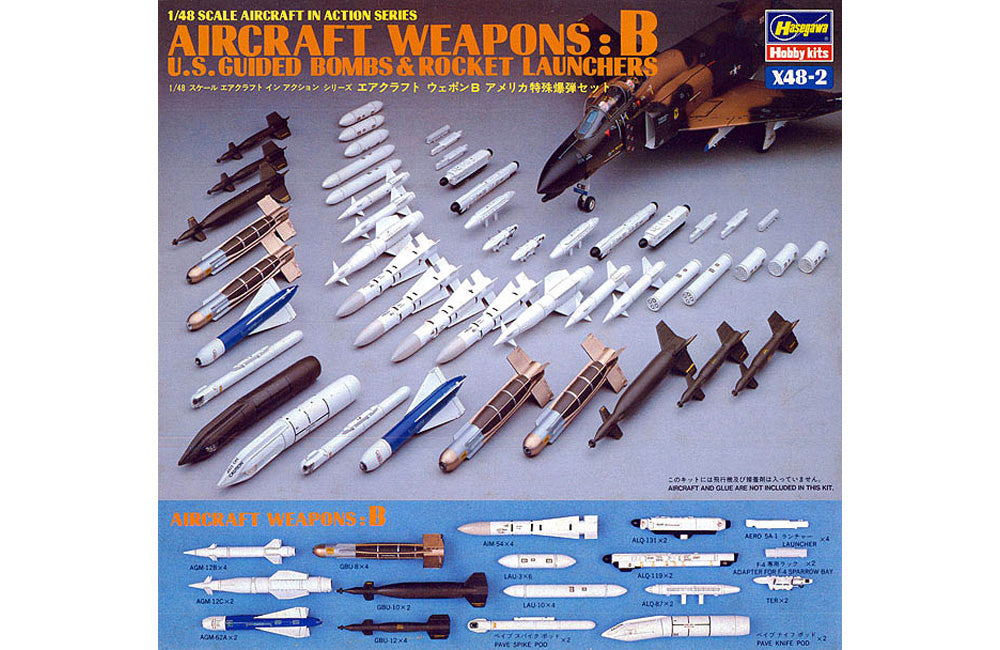Hasegawa 1/48 U.S Aircraft Weapon Set B Kit HAX482
Hasegawa 1/48 U.S Aircraft Weapon Set B Kit HAX482 will be backordered from our supplier. Delivery will take between 3-5 working days & orders will be despatched once completed.
Sign up to be the first to know when this product is back in stock!
Description
Description
Hasegawa 1/48 U.S Aircraft Weapon Set B Kit HAX482
The AGM-12 Bullpup was an American air-to-ground and air-to-water missile from the Cold War period. Its first prototypes appeared in the mid 1950s, and mass production began in 1959 and continued until 1970. The AGM-12 was a missile with a range of 5,000 to 12,000 meters, capable of carrying a warhead weighing from 113 to 453 kg, and its total mass - depending on the version - ranging from 259 to 810 kg.
The AGM-12 Bullpup was created in response to the US Navy's post-Korean demand (1950-1953) for a missile capable of destroying surface targets from a distance safe for the carrier aircraft. The AGM-12 was originally based on a 113 kg bomb body, but a rocket engine and a guidance system were added to it. The latter was the line of sight guidance system and required constant eye contact of the operator with the target (the so-called MCLOS guidance). Several versions of the AGM-12 missile were developed in the course of serial production. The first to be produced on a large scale was the AGM-12A. The next version is AGM-12B, which had a liquid fuel drive, which allowed to increase the range and the transferred head. A version of the AGM-12D was also developed, which was planned to be equipped with a nuclear warhead W-45 with a capacity of up to 15 kT. Based on this version, the AGM-12C model was created, which had a conventional warhead. The last version of the AGM-12 missile was the E model with an anti-tank warhead. AGM-12 Bullpups were used by many American aircraft, including: A-4 Skyhawk, A-6 Intruder, A-7 Corsair II, F-8 Crusader and F-4 Phantom II. Missiles of this type were also used in Australia, Greece, Denmark, Norway, Turkey and Great Britain. They were used on a relatively large scale during the Vietnam War in 1964 / 1965-1975.
GBU-10 Paveway is a modern American laser guided aerial bomb. Its first prototypes appeared in the first half of the 1970s, and it was used by the US armed forces in 1976 and remains there to this day. GBU-10 Paveway is capable of carrying a warhead weighing up to 428 kg with a total curb weight of 1,162 kg.
The GBU-10 Paveway was developed and manufactured by Raytheon and Lockheed Martin, based on the traditional Mk. 84. Modernization of the Mk. 84 consisted in adding a special head guiding the laser beam and ailerons correcting the fall of the bomb. GBU-10 requires highlighting with a laser target pointer. Two generations of these bombs appeared in the course of production. He represents the first GBU-10A / B Paveway I , the second is the GBU-10E / B and F / B Paveway II. The difference - apart from the design of the fins - is primarily that the Paveway II has a homing head that is cheaper to produce and more sensitive, which increases its accuracy and effectiveness. The main carriers of these bombs are the F-111 and F-15 E Strike Eagle planes. In addition, it can be carried by, among others: F-16 Fighting Falcon or F / A-18 Hornet. In the course of Operation Desert Storm in 1990-1991 bombs GBU-10 Paveway showed 76% effectiveness in hitting targets.
GBU-12 Paveway is a modern American laser guided aerial bomb. Its first prototypes appeared in the first half of the 1970s, and it was used by the US armed forces in 1976 and remains there to this day. GBU-12 is capable of carrying explosives (Tritonal and PBNX) weighing up to 87 kg with a total empty weight of 230 kg.
The GBU-12 Paveway was developed and manufactured by Raytheon and Lockheed Martin, based on the traditional Mk. 82 with a weight of 227 kilograms. Modernization of the Mk. 82 consisted in adding a special head guiding the laser beam and ailerons correcting the fall of the bomb. The first element was originally developed by Texas Instruments, which later became part of Raytheon. GBU-12 requires highlighting with a laser target pointer. Two generations of these bombs appeared in the course of production. He represents the first GBU-12 Paveway I , the second is the GBU-12 Paveway II. The difference - apart from the design of the fins - is primarily that the Paveway II has a homing head that is cheaper to produce and more sensitive, which increases its accuracy and effectiveness. The main carrier of these bombs is the F-111 plane. In addition, it can be carried by, among others: F-15 Strike Eagle, A-10 Thunderbolt II, F-16 Fighting Falcon or F / A-18 Hornet. In the course of Operation Desert Storm in 1990-1991 bombs GBU-12 Paveway showed 88% effectiveness in hitting targets.
Kit does NOT contain paints and glue.
Here are the basic tools and materials you need:
- Pilers for cutting plastic parts.
- Modelling penknife.
- File or sandpaper.
- Cement for plastic models.
- Brush or airbrush.
- Modelling paints.
Payment & Security
Payment methods
Your payment information is processed securely. We do not store credit card details nor have access to your credit card information.




